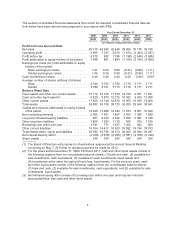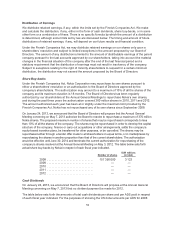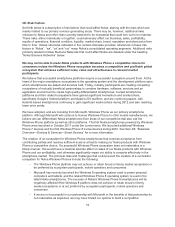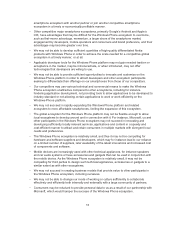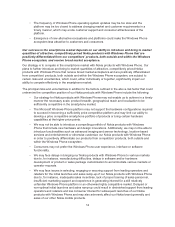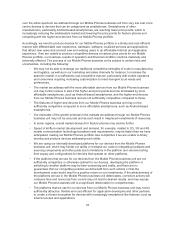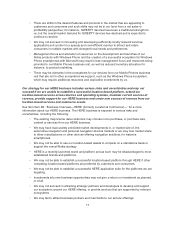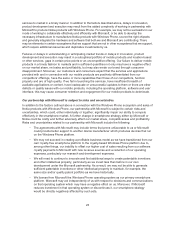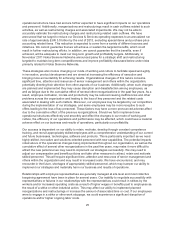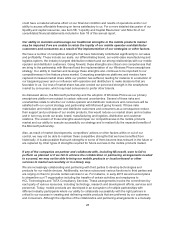Nokia 2012 Annual Report Download - page 20
Download and view the complete annual report
Please find page 20 of the 2012 Nokia annual report below. You can navigate through the pages in the report by either clicking on the pages listed below, or by using the keyword search tool below to find specific information within the annual report.management and technical personnel from our business and harm our reputation. Any diminution of
the protection that our own intellectual property rights enjoy could cause us to lose some of the
benefits of our investments in research and development.
In 2012, we continued to work to enforce our patents against unlawful infringement and realize the value
of our intellectual property, including filing patent suits, entering into patent license agreements and
through divesting patents. Patent license agreements can cover both licensee’s past and future sales.
The portion of the income that relates to past sales is not expected to have a recurring benefit and
ongoing patent income from licensing is generally subject to various factors that we have little or no
control over, for instance sales by the licensees. There are no guarantees that our actions to generate
intellectual property-related revenue will lead to favorable outcomes, such as patent license agreements
on favorable terms to us or that we would be able to utilize our patent portfolio for revenue generation to
a similar extent going forward. While we have various licensees, a significant portion of licensing
revenues is generated from a limited number of licensees and as such issues or ends of contracts in
relation to these select licensees could have a significant effect. Due to various reasons including the
above, our intellectual property related revenue can vary considerably from time to time and there are no
guarantees that past levels are indicative of future levels of intellectual property related revenue.
We face intense competition in mobile products and in the digital map data and related
location-based content and services markets.
We experience intense competition in every aspect of our business and across all markets for our
mobile products. Mobile products markets are segmented, diversified and increasingly commoditized.
We face competition from a growing number of participants in different user segments, price points and
geographical markets, as well as layers of the mobile product using different competitive means in
each of them. Such layers include the hardware and component layers as well as the software and
application layers of a mobile product. In some of those layers, we may have more limited experience
and scale than our competitors. This makes it more difficult and less cost-efficient for us to compete
successfully with differentiated offerings across the whole mobile products market against more
specialized competitors. It also limits our ability to leverage effectively our scale and other traditional
strengths, such as our brand, hardware assets, manufacturing and logistics, distribution, strategic
sourcing, research and development, intellectual property and design, to achieve significant
advantages compared to our competitors. We have been historically more successful where our mobile
devices are sold to consumers in open distribution through non-operator parties. The increase in
markets with operator-driven distribution and business models where operator subsidies are prevalent
may adversely affect our ability to compete effectively in those markets. We are increasingly seeing
such developments taking place in markets where we have been traditionally strong, for instance in
China. Additionally, our scale benefits may be adversely affected as new regional or operator
requirements are introduced.
In the smartphone market, we face intense competition from traditional mobile device manufacturers
and companies in related industries, such as Internet-based product and service providers, mobile
operators, business device and solution providers and consumer electronics manufacturers. Some of
those competitors are currently viewed as more attractive partners for application developers, content
providers and other key industry participants, resulting in more robust global ecosystems and more
appealing smartphones; have more experience, skills, speed of product development and execution,
including software development, and scale in certain segments of the smartphone market; have a
stronger market presence and brand recognition for their smartphones; have created different business
models to tap into significant new sources of revenues, such as advertising and subscriptions; or
generally have been able to adjust their business models and operations in an effective and timely
manner to the developing smartphone and related ecosystem market requirements.
19


